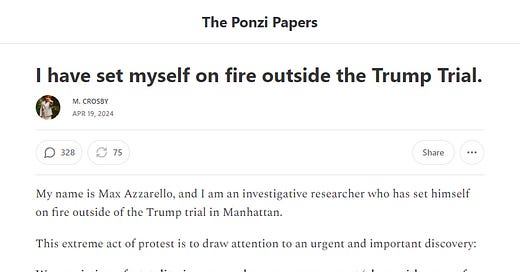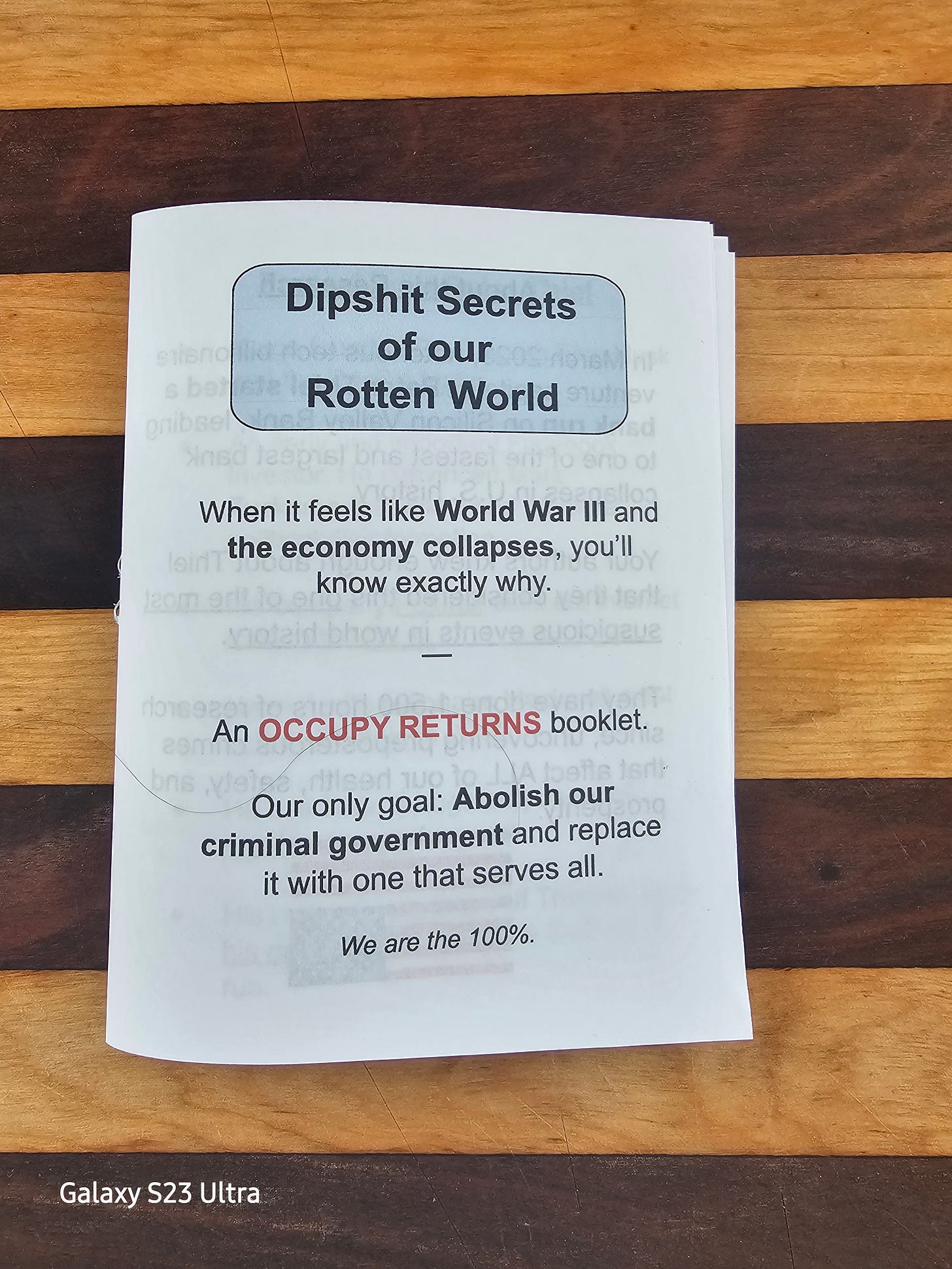Substack is a hell of a platform. Check out what this guy did to try and get clicks:
All suicide is bad, and self-immolation has got to be one of the worst possible ways to go out. It’s absurdly painful, and if you survive it you live the rest of your life looking like Deadpool had a baby with Freddie Kruger and He Jiankui used CRISPR to splice the fetus with a naked mole rat. I do not wish it on anyone.
But I do think we need more of it in this country, and I think the people who do it should be exacted the highest possible media praise, their causes and manifestos shouted from the heavens by all media nationwide, no matter how weird those causes or manifestos may be. So we’re going to do that, right now. We will praise Max Azzarello, and spread his weird message as far as HWFO can spread it, even though we don’t believe it ourselves.
Then we’ll talk about why people burn themselves alive, and more importantly why HWFO is celebrating that at the end, which is the actual lesson in the article. A self-immolation media contagion is far healthier for all involved than a spree-shooter media contagion. Read on to see why. But first, we immortalize the Max Azzarello manifesto.
Max’s Message
Surprisingly his Substack account is still up. You can read it yourself if you like:
If that link ever dies, click here to check the Wayback Machine. His thesis reduces to this:
Peter Theil crashed Silicon Valley Bank (SVB) on purpose to give crypto billionaires an offramp to get their money out of crypto, which means all crypto is about to collapse. When crypto goes insolvent it will destroy half the stock market. Crypto is responsible for global inflation. The US government released Covid-19 to cover up a stock market pump-and-dump by Stanford’s “StartX.com” and by Jeffery Epstein, which was somehow related to crypto.
Elections are kayfabe. Harvard is an organized crime front. The Simpsons are a psyop. The media is evil and a source of moral decay. Zuckerberg and Musk are crypto criminals. The elites know capitalism is unsustainable and are in the process of rolling out fascist dystopia. Stanley Kubrick was a secret fascist. All media is a psyop. Download my Booklet.
It’s disappointing by conspiracy theory standards. There’s lots of verifiably wrong information in it, and nothing really new or creative like we saw in the Christchurch shooter manifesto which was later scrubbed from the web. Like all conspiracy theories, he ties tangled webs around certain truths to justify the theory, and like most conspiracy theories, his theory contains a few things I agree with. This, for instance:
As it turns out, we have a secret kleptocracy: Both parties are run by financial criminals whose only goals are to divide, deceive, and bleed us dry. They divide the public against itself and blame the other party while everything gets worse and more expensive and handful of people take all the money.
I wouldn’t say it’s exactly secret, though. And I wouldn’t say it’s coordinated in the way he thinks it is. I think these sorts of things are just the inevitable bottoming out of a multivariate system wherein each individual actor makes the best choice for them, which leads to the perception of collective action when paired with egregorical groupthink. We covered that here, discussing Majid Nawaz’s appearance on Rogan.
I’m sympathetic to his description of Harvard as an organized crime front, as we discussed here, and his depictions of elections being kayfabe, as we discussed here. If only this dude could have been an HWFO reader, we might have been able to chill him out. The media trending towards apocalypse content might just be a function of market dynamics, not necessarily a coordinated effort by the Illuminati. Someone should have asked him to calculate the relative market cap of crypto vs everything else and to point to the crypto holdings of Meta and such, to justify his theory. But he burned himself alive so he probably wasn’t a thoroughly clear-headed dude anyway.
That aside, he should be commended and praised. He had something to say, and he wanted everyone to hear it so badly he was willing to give up his life so someone, anyone, would listen. Just like the spree shooters, but without the spree shooting. And the eruption in self immolation we’ve seen this year seems to be a social contagion, just like the spree shooters.
Self Immolation, a Study in Pastel
Political protest by self immolation was popularized by Thích Quảng Đức in 1963, but the Wikipedia list of political self immolation protests actually lists two earlier ones, in China and Thailand. Thích Quảng Đức clearly set the trend, however, leading to a total of six in Vietnam in 1963, seven in India over 1964 and 1965, and then five in the United States that same year in protest over the Vietnam war. Usually self-immolation world-wide comes in ones and twos, but in the Pacific Rim and United States, they come in clusters. Tibet is the reigning world champ of self-immolation, but among white western countries the USA seems to be leading the pack. The three most recent self immolations globally were here:
Max, protesting a variously complex ponzi scheme
Three in five months makes this a “suicide cluster,” according to the people who study cluster suicide.
Alex Mesoudi in 2009 described and modeled two kinds of suicide clusters - point clusters which were localized in time and space as people who directly knew each other all committed suicide, and mass clusters, where people connected through mass media to a famous person committing suicide followed suit. His research is interesting, but not specifically applicable to politically-motivated self-immolation.
Stewart Stack is a suicide expert who has looked deeply into the association with mass media coverage of suicide. Most work in this academic space revolves around creating media protocols that reduce mass clusters such as the Vienna Subway Suicides and the Golden Gate Bridge Suicides, suicides which are often classified as “attention seeking.”
It’s a very big no-no in the psychological community to describe any suicide attempt as “attention-seeking,” in part because many suicides are misclassified as such and ascribing them to attention seeking behavior is a way to minimize or disregard more serious underlying issues.
But “I JUST SET MYSELF ON FIRE SO YOU’LL READ MY SUBSTACK” could not possibly be more obvious attention seeking, as it’s literally a play in the overall attention economy. Suicide as a “cry for help” is widely accepted in the medical community, so whether a suicide is attention-seeking or not depends on how you define attention seeking itself. Owing to how rare self immolation is, I can find no studies on it, so let’s proceed as if we can all agree that setting yourself on fire in a public place so people will listen to you is a way to not only seek, but demand, attention. Can we leverage this to society’s advantage?
Spree Shooting, a Study in 556
Spree shooters in the United States are much better studied, and studies have repeatedly shown that they follow a media contagion model. Sherry Towers et al in 2015 found this:
We find significant evidence that mass killings involving firearms are incented by similar events in the immediate past. On average, this temporary increase in probability lasts 13 days, and each incident incites at least 0.30 new incidents (p = 0.0015). We also find significant evidence of contagion in school shootings, for which an incident is contagious for an average of 13 days, and incites an average of at least 0.22 new incidents (p = 0.0001).
This is one of many studies which show such a contagion effect, curiously similar to the mass suicide cluster effect referenced above. Researchers who study mass shooters point out specifically that each mass shooting is a suicide attempt.
Peterson: There’s this really consistent pathway. Early childhood trauma seems to be the foundation, whether violence in the home, sexual assault, parental suicides, extreme bullying. Then you see the build toward hopelessness, despair, isolation, self-loathing, oftentimes rejection from peers. That turns into a really identifiable crisis point where they’re acting differently. Sometimes they have previous suicide attempts.
What’s different from traditional suicide is that the self-hate turns against a group. They start asking themselves, “Whose fault is this?” Is it a racial group or women or a religious group, or is it my classmates? The hate turns outward. There’s also this quest for fame and notoriety.
Jennifer Johnston and Andrew Joy analyzed media behavior in 2016, and determined that the way the media covers mass shootings exacerbates copycats and promotes this contagion:
“If the mass media and social media enthusiasts make a pact to no longer share, reproduce or retweet the names, faces, detailed histories or long-winded statements of killers, we could see a dramatic reduction in mass shootings in one to two years,” she said. “Even conservatively, if the calculations of contagion modelers are correct, we should see at least a one-third reduction in shootings if the contagion is removed.”
And HWFO in prior analyses has pointed out that in a distributed media model, no central coordination can exist to suppress media coverage of mass shooters because smaller media players can break rank and cover the shooting. A game-theory Nash Equilibrium evolves where everyone who doesn’t cover the mass shooting loses money to those who do:
This creates a media dilemma which causes 33% more dead people, with seemingly no solution.
But I have an idea.
Burning Our Way Out
You can’t tell the media to not cover something they’ll make money on, because some other media outfit will just pick up the slack and make the money. But one thing you can do is tell the media it’s ok to make money off of something.
With political self-immolation, responsible media generally shies away from publishing the manifestos of the self immolators, because they’re following accepted suicide protocol. But imagine they were encouraged to publish the manifestos, and the upcoming crop of spree shooters saw that their manifesto was going to get buried if they shot up a school but would have been highly publicized if they burned themselves up?
We’d likely see some ratio of future mass shooters be converted to self-immolators.
Since self-immolation to get attention is far healthier for those around you than spraying those around you with bullets to get attention, any conversion from spree shooter to self-immolator is a win for all involved, including the attention seeker.
For this reason, I publish Max Crosby’s message. I praise him for his actions, not because they made any sense to me, but because his sacrifice will be a twofold positive influence for the country. One, he will not end up shooting anyone were he prone to do so. But further, his contribution to the suicide mass cluster may convince another future shooter to burn themselves up as well.
Praise be to the self immolators, for their sacrifice will perpetuate the suicide cycle long enough to scoop up some dork who’d shoot up a shopping mall.
Amen.








It seems to me the key difference here between the Self-Immolator and the Spree Shooter is the self-hatred turned outwards mentioned in the Peterson quote. The Self-Immolator is a suicidal narcissist sans the murderous intent, unlike his counter-part the Spree Shooter.
If the body count matters for the Spree Shooter then by encouraging the use of fire in place of bullets, might we be instead fomenting deadly arson and its attendant property destruction?
I hope Congress jumps on the self-immolation bandwagon.